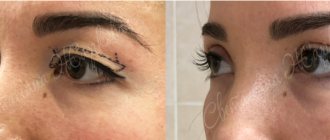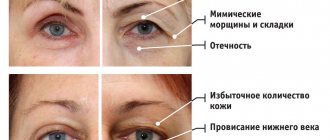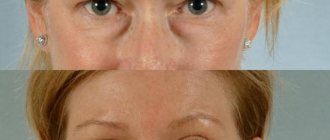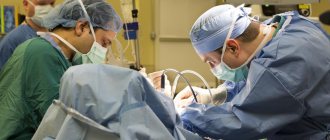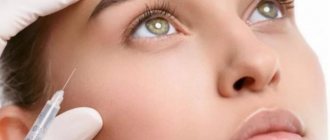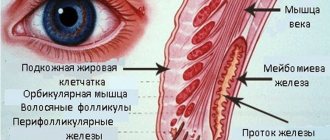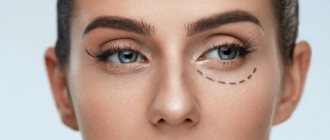Blepharoplasty “Cleopatra's Look” is a plastic surgery on the upper eyelid, during which the upper corner of the eye is raised. A distinctive feature of this operation is the short rehabilitation period. This technique got its name thanks to the famous Queen Cleopatra, who had almond-shaped eyes. The author's correction method belongs to Amdajra Al-Yousef. This type of correction has recently become very popular. The effect after surgery lasts about 12 years.
The essence of the technique
The “Cleopatra's Look” technique is a type of blepharoplasty. It is quite possible to carry out such a correction in combination with other plastic surgeries, for example, rhinoplasty, eyelid correction, lower plastic surgery. The plastic surgeon chooses the angle of the incision individually for each patient, due to which the scars after surgery are practically invisible, and those that are noticeable disappear over time.
Please note that this technique in the modern world is common not only among mature women, but is actively practiced among young people who strive to gain individuality in everything. Today, the number of owners of almond-shaped eyes as a result of the operation is already measured in the thousands. The long-term effect after the procedure plays an important role; it sometimes reaches 20 years.
Answers to common questions
What anesthesia is it done under?
The use of local anesthesia is possible if only the lower or upper eyelid needs to be corrected. It is often combined with sedation, which allows the patient to fall into a shallow sleep.
If a circular type of manipulation is required, doctors insist on administering a general anesthetic. This is explained by the fact that the manipulation takes longer and requires increased concentration of the specialist.
In addition, when choosing an anesthesia, it is necessary to take into account factors such as the patient’s age, intolerance to the anesthetic, psycho-emotional state, and the results of a diagnostic examination.
Do I need to use scar ointment after?
After surgery, the use of special ointments is required that have a wound-healing effect and accelerate tissue renewal processes.
From what age and up to what age can it be done?
The relevance of the operation has been proven for people of any age category. For cosmetic purposes, the procedure is recommended upon reaching 30 years of age. For medical reasons, it can be performed earlier, even if the patient has not reached the age of majority.
What time of year is best to do it?
The autumn-winter period is considered optimal. Doctors explain this by saying that due to the short daylight hours, the exposure to ultraviolet radiation on the treated areas is reduced, preventing the development of complications or reducing the severity of the effect.
Indications for blepharoplasty
In this case, the indications can only be aesthetic. The operation allows you to get rid of congenital and acquired defects in appearance. It is allowed to have plastic surgery from the moment you reach adulthood; there are no more age restrictions.
The fact that most women resort to this procedure after the age of 35 is due to age-related changes in appearance. The corners of the eyes tend to naturally droop, and wrinkles in the lower eyelid area and drooping folds of skin aggravate the situation. Overall, the face becomes dissatisfied, looks tired and lifeless.
How our eyes work and why the skin in this area ages faster
Age-related changes in the face in general and the eyes in particular are manifested by drooping tissue. The laws of gravity have not been canceled. The eye is a very complex anatomical formation. This is a functional unit, an appendage of the brain, it is ideally well protected by a kind of bone “cup”. The tissue of the eye itself is quite dense; there is a lining and fatty bags around it. Of course, this is all a kind of image, and not an exact anatomical definition. We want all wonderful readers interested in blepharoplasty to understand the topic of our article. Our eyes are a very important organ for us. Therefore it is very well protected. This is how tears protect the eye from infections. There is also a muscular apparatus that allows the eye to move. There are muscles that protect the eyes. The entire muscular apparatus of the orbital region of the eye works automatically.
Pay attention: you do not notice eye movements, blinking. By the way, when a person begins to notice how he blinks, this indicates that he needs to sleep. This is an important marker of fatigue that everyone who drives needs to be aware of. We repeat: if a person notices how he blinks, he may fall asleep while driving.
With the help of our eyes we not only see, we communicate non-verbally. We learn to “shoot” with our eyes from a very early age on an unconscious level. In fact, all the “mystery” and expressiveness of the look lies in the functional state of the periorbital muscle zone. How can we watch? In many different ways: with squinting, smiling, opening or bulging eyes - a person’s non-verbal communication potential is very great. There are different theories why the first signs of aging appear in the area around the eyes: especially thin and delicate skin in this area, eye mobility. Sometimes this happens very early and is associated with premature aging syndrome. Most often, the first signs of ptosis (drooping, drooping) of the eyelids begin to appear around the age of thirty. The look gradually becomes “heavy” and tired. To regain their former “fresh and open” look, people turn to a plastic surgeon for blepharoplasty. But you need to understand that the main task of the surgeon is not only to make you younger. First of all, the doctor performing blepharoplasty must take care of maintaining the functionality of the eyes and your safety. Unlike conventional surgery, plastic surgery does not involve the risks of not performing the operation.
Contraindications
Like any surgical intervention, blepharoplasty has a number of limitations. These include:
- hypertension;
- dry eyes;
- hepatitis;
- HIV;
- pathologies of the thyroid gland;
- oncology;
- increased intraocular pressure;
- hypotension;
- diabetes;
- diseases of the cardiovascular system;
- problems with blood clotting;
- myopia, or other chronic eye diseases
If at least one of the contraindications is identified, the operation will have to be postponed or canceled completely, otherwise it may end in failure. In some cases, you may need to consult a related specialist: an ophthalmologist, cardiologist, endocrinologist, etc.
Preparing for blepharoplasty
In order to fully identify possible contraindications to the correction, it is necessary to undergo a series of tests for:
- HIV;
- hepatitis;
- biochemical and clinical blood test;
- coagulogram
Fluorography and ECG will be required.
Before undergoing plastic surgery, you will definitely need to consult an ophthalmologist. The specialist will check your vision and the volume of tear fluid. The therapist will examine the patient for hypertension, and the cardiologist will rule out heart disease.
If “Cleopatra’s Look” blepharoplasty is performed in combination with lower eyelid surgery, you may need to see a nephrologist, allergist, or endocrinologist. In some cases, bags under the eyes may indicate diseases of the internal organs.
Next, you will need to consult an anesthesiologist who will help you choose the right anesthesia. In some cases, the patient may be allergic to lidocaine or novocaine, in which case general anesthesia will be needed. The author of the technique prefers local anesthesia with sedation.
Before blepharoplasty, you will need to remove eyelash extensions and lenses. You should not overuse cosmetic procedures on the eve of surgery. You should stop taking medications, especially those that affect blood clotting. If you have ever used such drugs, be sure to tell your doctor. They can cause bleeding during surgery.
Basic recommendations for preparation:
- refuse to visit the solarium
- no to cigarettes and alcohol, these harmful substances contribute to slow tissue regeneration after plastic surgery;
- follow the correct drinking regime to speed up rehabilitation
Photos "before and after"
Circular blepharoplasty. One of the indicators of successful blepharoplasty is the stability of the lower eyelid. Changing the curvature of the line even by 1 mm gives the effect of “operated” eyelids. Photos were taken “before” and 9 days “after” the operation. Subsequently, the seam will almost completely turn white and disappear. Performed by surgeon: Andrey Iskornev.
A patient with rounded eyelids after previously performed blepharoplasty (photo on the left). The photo on the right shows the corrected shape due to canthoplasty and lipofilling of the infraorbital areas. Surgeon: Iskornev A.A.
SMAS face lift, circular blepharoplasty, forehead lift, neck lift, CO2 laser resurfacing. Performed by surgeon: Andrey Iskornev.
Upper and lower transconjunctival blepharoplasty. Neck liposuction. Thread neck lift. Removing Bish's lumps. Botulinum therapy. Lip contouring with Equio. Surgeon: Iskornev Andrey.
Photo from the patient’s personal archive. Completed by: Iskornev A.A.
Elena Savitskaya “before” and 6 months “after” blepharoplasty. Surgeon: Iskornev Andrey.
Review by Elena Savitskaya
SMAS face and neck lift, blepharoplasty of the upper and lower eyelids. Surgeon: Iskornev Andrey.
Done by Andrey Iskornev.
Done by Melnikov D.V.
Bags or dark circles under the eyes occur not only due to pathology. Sometimes, after a party or drinking a lot of liquid at night, bags can appear in healthy people. These are fatty hernias of the lower eyelids.
Transconjunctival blepharoplasty can help get rid of dark circles or bags under the eyes. Excess fat hernias are removed without visible incisions. As a result, the bags will disappear, and dark circles will not appear even after the New Year holidays.
Completed by: Vasiliev Maxim.
SMAS face and neck lift, upper eyelid blepharoplasty. Surgeon: Iskornev A.A.
Please note that after surgery the tragus of the auricle remains in place. The stitches are hidden behind it and from the outside it is generally unclear what happened, but the face looks much fresher.
Blepharoplasty “Cleopatra’s Look”: procedure
If local anesthesia is used, the patient will be immersed in a shallow sleep, in which all unpleasant sensations will be minimized. The plastic surgeon will make an oblong incision, according to the author’s technique, at an angle at which the scars after the operation will not be noticeable. After which excess skin and fatty tissue will be excised and the corners of the eyes will be raised.
The operation lasts a minimum of 30 minutes and a maximum of two hours. The course depends on the complexity of the correction and the individual characteristics of the patient. After all the necessary manipulations have been carried out, cosmetic stitches will be applied and a special patch will be applied. Approximately 2 hours after surgery, if there are no complications, the patient can go home. During the first 24 hours, one of your relatives must be nearby to provide the necessary assistance.
Blepharoplasty "Cleopatra's Eye"
The image of Queen Cleopatra of Egypt is reflected not only in world fiction, but also in examples of ideals of beauty among different nations.
The almond-shaped eye shape given to Cleopatra by nature with amazing frequency is elevated by masters of art to the rank of “gold standard of beauty.” Aesthetic surgery, aimed at serving beauty, adopted the model of Cleopatra’s face and created a special method for correcting the shape of the eyes, called “Cleopatra’s Eye” and gaining increasing popularity in Russian cosmetology clinics. The Cleopatra Eye technique is a type of upper blepharoplasty. It is performed on the upper eyelid with raising the upper corner of the eye.
For the surgeon, two features of the “Cleopatra’s Eye” technique are significant, which serve as the basis for dividing the types of blepharoplasty into “classical” and “Cleopatra’s Eye”.
The first feature of the operation using the “Cleopatra's Eye” technique is a higher excision of the muscle and skin flap, which causes the lateral edge of the upper eyelid to be lifted upward and gives a small and characteristic bend in the middle of the projection of the eyeball onto the eyebrow.
The second feature is the surgeon’s work in the temporal region, during which he removes a wedge-shaped muscle flap, pulls the corner of the eye up and attaches it to the temporal fascia (canthopexy). It is canthopexy that allows you to strengthen the new shape of the eye and maintain the result for many years.
This technique allows you to create an anatomically intact almond-shaped eye without traces of a specially performed plastic surgery. Currently, surgery using the “Eye of Cleopatra” technique is one of the most popular in our clinics.
Indications for surgery using the “Eye of Cleopatra” technique:
- change in eye shape
- tired look
- ptosis (drooping) of the upper eyelid
- excess skin of the upper eyelids
- excess fatty tissue in the periorbital area
- drooping eyebrows and forehead skin
- laxity of the muscles of the periorbital zone
- wrinkles around the eyes
- exophthalmos – protrusion of the eyeball
- eye asymmetry
Contraindications to surgery using the “Eye of Cleopatra” technique:
- persistent arterial hypertension;
- systemic collagenoses;
- chronic infectious and viral diseases;
- acute inflammatory processes in the facial area;
- glaucoma;
- retinal detachment;
- diabetes;
- severe cardiovascular diseases;
- systemic connective tissue diseases (lupus erythematosus, scleroderma);
- disorders of the blood coagulation system;
- the presence of inflammatory elements on the skin of the eyelids.
Carrying out the operation:
The operation is carried out in four stages. The first stage is making a contour incision and removing skin from the outlined area of the surgical field. The next stage is the removal of excess orbicularis oculi muscle, which opens access to “fatty hernias”. When performing blepharoplasty using the “Cleopatra's Eye” technique, the excision is carried out with a vector to the middle of the eyebrow to achieve an anatomical almond-shaped shape. The incision should also include the temporal region, where canthopexy is performed after wedge excision. The third stage involves the isolation and removal of excess fatty tissue in the postorbital region. At the fourth and final stage, layer-by-layer stitching of the muscle and skin is carried out.
Anesthesia:
The operation is performed under local anesthesia; additional oral sedatives may be used. After the operation, an hour's observation of the patient's condition is sufficient; there is no need for the patient to stay in the hospital.
Rehabilitation requires compliance with the following rules:
- in the first days after surgery, avoid drinking large quantities of liquids, and also avoid drinking alcohol;
- take the antibiotic UNIDOX SOLUTAB for seven days - one tablet (at a dose of 100 mg) once a day, after meals;
- If there are noticeable bruises, use Traumeel S or Bruise OFF cream to speed up the resorption of hematomas. Apply the cream morning and evening to the hematoma area. It is strictly forbidden to apply cream to the seam area!
- sleep on your back for 4-5 days;
- avoid trauma to the operating area;
- refrain from visiting the bathhouse, sauna, solarium, swimming pool for 1 month;
- do not open wound coverings until the sutures are removed without the consent of the attending physician;
- Avoid intense physical activity for a month.
Postoperative rehabilitation takes from 5 to 10 days. The stitches are removed on days 6-9. If there are small traces of the suture after surgery, they are corrected by peeling or grinding methods in 1-3 sessions until the traces completely disappear.
Result:
The final result after the operation is observed after 3-4 months, when traces of the operation completely disappear, and lasts up to 20 years or more.
Rehabilitation after surgery
In the first days after blepharoplasty, bruising and bruising and swelling may occur. To minimize discomfort, you need to give your eyes complete rest. The patient herself must also give up mental and physical stress.
The stitches will be removed no earlier than 5 days later. The rehabilitation itself can last up to two weeks, after which the patient can return to her usual rhythm of life. It will be possible to fully evaluate the result of blepharoplasty in a couple of months. During the recovery period, the doctor may prescribe special ointments and compresses that promote speedy healing.
It is recommended to adhere to a healthy lifestyle, be less exposed to sunlight, and sleep only with the head of the bed raised.




